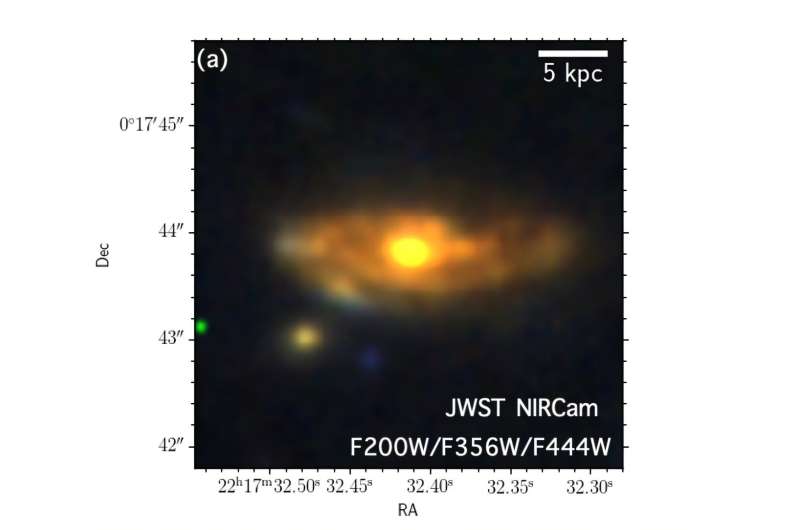Using the James Webb Space Telescope (JWST) and the Atacama Large Millimeter/submillimeter Array (ALMA), an international team of astronomers have observed a giant spiral galaxy designated ADF22.A1. Results of the observational campaign, published October 29 on the pre-print server arXiv, provide more insights into its inner structure.
At a redshift of 3.09, ADF22.A1 is a giant barred spiral galaxy residing in a proto-cluster known as SSA22. Previous observations have found that it is a dusty star-forming galaxy (DSFG) hosting an intrinsically bright yet heavily obscured active galactic nucleus (AGN).
ADF22.A1 is perceived by astronomers as a unique laboratory to explore how the most massive galaxies and supermassive black holes (SMBHs) accumulate their mass and ultimately evolve into the most massive elliptical galaxies. However, still very little is known about the structure and properties of this galaxy due to heavy dust extinction affecting its rest-frame ultraviolet appearance.
That is why a group of astronomers led by Hideki Umehata of Nagoya University in Japan has employed JWST and ALMA to investigate ADF22.A1 as these two instruments have the capability to explore the structure and kinematics of this galaxy.
“With the advent of the JWST and ALMA, we can now resolve its [ADF22.A1] structure and kinematics, providing unprecedented insights into the physical processes shaping the evolution of massive galaxies,” the researchers explained.
The observations performed by Umehata’s team revealed a spiral-like stellar structure of ADF22.A1 tracing rest-frame optical-to-near-infrared emissions. It was found that the galaxy has an effective radius of approximately 22,800 light years, comparable to that of local galaxies, suggesting accelerated size growth in the proto-cluster core.
Furthermore, the observations detected a bright, compact dusty core at the center of ADF22.A1, which indicates an active growth phase of a proto-bulge. It was found that the dust continuum is not just concentrated in the core, as seen in some known DSFGs, but is distributed across the disk.
This, according to the astronomers, suggests that active star formation is also occurring in the disk, accompanied by significant dust production.
By analyzing emission lines of ionized carbon, the researchers derived the rotation velocity of ADF22.A1, which was calculated to be about 530 km/s. They also found that the galaxy has a relatively high specific stellar angular momentum.
Summing up the results, the authors of the paper conclude that ADF22.A1 is an unusually fast-rotating, giant spiral galaxy and that some mechanism must have rapidly spun up the disk of this galaxy within only two billion years after the Big Bang.
“Cold accretion, combined with mergers, is the most plausible explanation,” the scientists wrote.
More information:
H. Umehata et al, ADF22-WEB: A giant barred spiral starburst galaxy in the z = 3.1 SSA22 protocluster core, arXiv (2024). DOI: 10.48550/arxiv.2410.22155
Journal information:
arXiv
© 2024 Science X Network
Citation:
Astronomers use JWST and ALMA to explore the structure of a giant spiral galaxy (2024, November 6)
retrieved 6 November 2024
from https://phys.org/news/2024-11-astronomers-jwst-alma-explore-giant.html
This document is subject to copyright. Apart from any fair dealing for the purpose of private study or research, no
part may be reproduced without the written permission. The content is provided for information purposes only.

